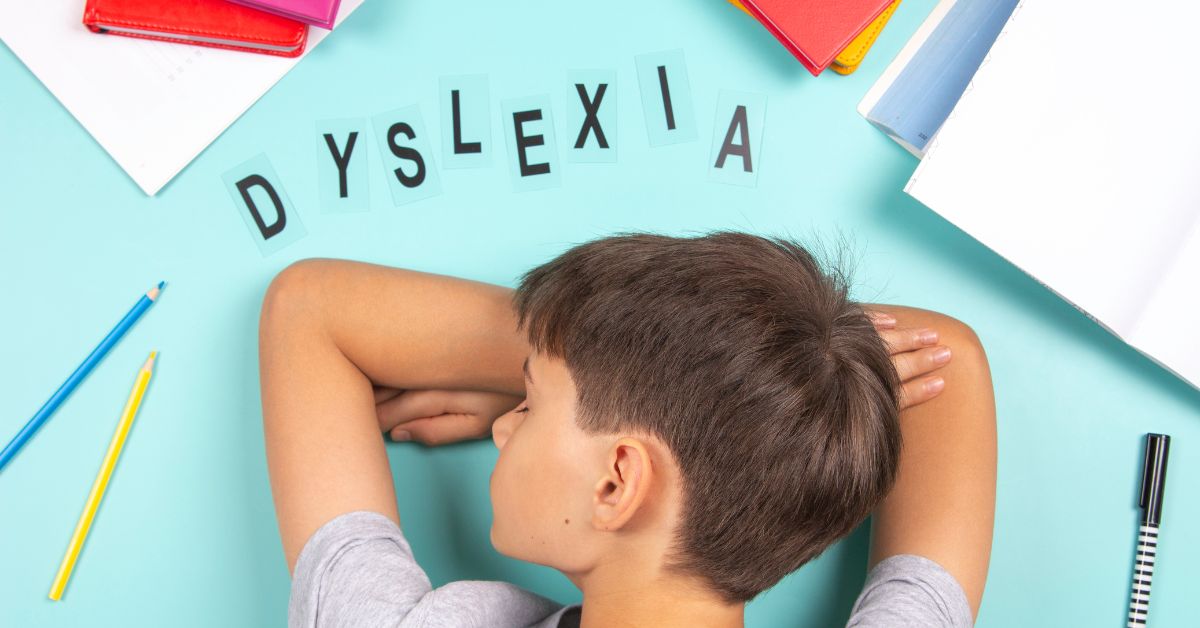Parents often first notice dyslexia when reading doesn’t “click” despite effort and support. Dyslexia is a language-based learning difference that affects how the brain processes written and spoken language. It is not a sign of low intelligence or motivation. Children with dyslexia can learn to read, write, and thrive with the right teaching methods and time.
This is where homeschooling children with dyslexia can shine: you can tailor instruction, use proven strategies, and move at a pace that builds skill and confidence.
What Dyslexia Is (and Isn’t)
Dyslexia affects phonological processing—the ability to hear and work with sounds in words. Children may struggle with decoding (sounding out words), spelling, reading fluency, and sometimes working memory and processing speed. Many also have strong strengths: creative problem-solving, spatial reasoning, storytelling, and big-picture thinking.
Dyslexia is lifelong, but early, structured help changes outcomes. With systematic instruction and regular practice, students build reading accuracy and speed. The goal isn’t to “cure” dyslexia; it’s to equip your child with tools that work for their brain.
Why Homeschooling Works Well for Dyslexia
Homeschooling gives you control over time, tools, and teaching. That flexibility reduces stress and creates steady progress. It also removes unhelpful comparisons and allows you to teach to mastery instead of a calendar.
- You can use structured literacy daily without being pulled off track by a class schedule.
- You can adjust pacing. If a skill needs three more days, you take three more days.
- You can teach with multisensory methods in every subject, not just reading.
- You can protect your child’s self-esteem by celebrating growth and avoiding public struggles.
Dyslexia-Friendly Homeschool Methods
The most effective reading instruction for dyslexia is structured literacy. It’s explicit (you teach skills directly), systematic (you follow a logical sequence), and cumulative (each new skill builds on the last). It also includes multisensory practice so kids see, hear, say, and write each pattern.
- Phonological awareness: blending, segmenting, and manipulating sounds.
- Phonics: teaching letter-sound patterns in a planned order, including vowel teams and syllable types.
- Decoding and encoding: reading and spelling taught together to reinforce patterns.
- Fluency: guided repeated reading with controlled text.
- Vocabulary and comprehension: taught directly, with plenty of oral language and background knowledge.
Short, focused lessons work best. Aim for 20–30 minutes of reading instruction, five days a week, with another 10–15 minutes for spelling. Keep a calm pace and end lessons on a success.
Homeschool Styles That Support Dyslexia
Choosing a homeschool style helps you organize your day and select materials. You can mix styles to fit your child’s needs.
- Structured/Traditional: Clear schedules and explicit teaching. Pairs well with structured literacy programs. Good for families who like routines.
- Charlotte Mason-Inspired: Rich read-alouds, narration, copywork, and short lessons. You can use audiobooks and dictation to reduce print load while building language.
- Montessori: Hands-on, concrete materials and independence. Works well for tactile learners; you can create letter-sound work with sandpaper letters and moveable alphabets.
- Project-Based: Real-world projects that blend reading, writing, math, and science. Use voice-to-text and visual aids to keep projects accessible.
- Unschooling/Interest-Led: Follow the child’s curiosity. Combine high-interest topics with targeted reading instruction to maintain buy-in.

Building a Dyslexia-Friendly Daily Rhythm
A predictable rhythm lowers anxiety and saves mental energy for learning. Think “consistency with flexibility.”
- Start with a warm-up: 3–5 minutes of phonemic awareness games.
- Move into phonics: teach one new pattern or review yesterday’s pattern.
- Practice decoding and encoding: read controlled texts; spell 8–10 words using the target pattern.
- Switch modalities: hands-on math, movement break, or nature time.
- Content learning: use read-alouds or audiobooks for history/science, followed by oral narration or a quick sketch-notes page.
Tools and Accommodations That Make a Difference
Assistive technology is not a crutch—it’s access. Use it early so your child can learn grade-level content while reading skills catch up.
- Audiobooks and text-to-speech: Learning Ally, Epic, Voice Dream Reader, Bookshare.
- Speech-to-text and dictation: Google Docs Voice Typing, built-in iOS dictation.
- Dyslexia-friendly fonts and formatting: larger spacing, tinted backgrounds, short line lengths.
- Note-taking supports: graphic organizers, sketch-noting, sticky notes, and color-coding.
- Time accommodations: longer time for writing, reduced problem sets with the same skill practice.
Choosing a Curriculum for Reading and Spelling
Look for programs that are explicit, systematic, and cumulative, with plenty of review and multisensory practice. Many families succeed with Orton-Gillingham-based programs and similar structured literacy options. The right program will:
- Teach sounds, patterns, and syllable types in a clear sequence.
- Integrate spelling with reading so patterns stick.
- Offer decodable readers that match the lesson sequence.
- Provide scripted or guided lessons to keep instruction consistent.
No single program fits every child. If you notice frustration or lack of progress after 6–8 weeks, adjust pacing, add more review, or try a different format while keeping the core principles.
Teaching Writing When Reading Is Hard
Writing draws on many skills at once. Separate idea generation from mechanics to lower the load. Let your child speak their ideas first, then use tools to capture them.
- Plan orally: discuss the topic, then jot quick bullet points together.
- Dictate first drafts: use speech-to-text so ideas flow.
- Edit in layers: content first, then spelling of taught patterns, then punctuation.
- Use templates: sentence frames, paragraph organizers, and checklists support independence.
When you teach spelling, focus on the patterns you’ve covered in phonics. Celebrate correct patterns, not just perfect words.
Math, Science, and History Without the Reading Bottleneck
Many children with dyslexia enjoy math and hands-on subjects. Keep text demands reasonable while you build reading skills.
- Use visual, step-by-step math programs and manipulatives. Read word problems aloud.
- Choose science kits, experiments, and videos. Have your child explain results orally.
- For history, rely on read-alouds, audiobooks, timelines, maps, and short narrated summaries.
- Grade for understanding, not for how much was read silently.
This approach lets your child grow in knowledge and confidence across subjects right now.
Social and Emotional Benefits of Homeschooling for Dyslexia
Homeschooling often reduces the daily stress that comes with frequent reading demands and timed tasks. Children can learn without constant comparison to peers. You can protect their love of learning by matching tasks to skill level and offering real choice. Many families also report better sleep, more time for hobbies, and stronger family relationships. When academics fit the child, their self-esteem grows—an important predictor of long-term success.
Measuring Progress Without Pressure
Track growth in simple, consistent ways. Keep a notebook or spreadsheet with weekly notes:
- New patterns mastered and words read correctly.
- Fluency checks: words correct per minute on a familiar passage.
- Dictation accuracy for taught patterns.
- Reading stamina: minutes of comfortable reading with decodable text.
If progress stalls for several weeks, tweak one variable at a time: slow the pace, add daily review, shorten lessons, or switch to a different decodable series. Small changes often restart growth.
Working With Professionals While You Homeschool
Many homeschool families partner with specialists. A formal evaluation can clarify your child’s profile and guide instruction. An educational therapist or dyslexia specialist can provide targeted lessons, while you reinforce skills at home. If your state offers services for homeschoolers, you may be able to access speech-language therapy, reading intervention, or testing supports. Keep a portfolio of work samples, progress notes, and any assessments to track gains and to advocate when needed.
A Sample Week for Homeschooling Children With Dyslexia
Here’s a simple framework you can adapt. Keep lessons short and purposeful.
- Monday–Thursday:
-
- Phonemic awareness (5 minutes)
-
- Phonics/structured literacy lesson (20–30 minutes)
-
- Decodable reading + spelling/encoding (15 minutes)
-
- Math with manipulatives (20–30 minutes)
-
- Read-aloud or audiobook for content (15–30 minutes) with oral narration
-
- Writing via dictation or guided organizer (10–15 minutes)
- Friday:
-
- Review games for phonics patterns
-
- Fluency practice with a familiar passage
-
- Hands-on project or field trip tied to science or history
-
- Light spelling review and a confidence-boost read
Adjust the time blocks to match your child’s age and attention.
Keeping Motivation High
Success fuels motivation. Set goals your child can reach in a week or two, then celebrate wins. Let your child choose topics for writing or library picks for audiobooks. Use games for review: word-building tiles, board games with reading cards, or timed “beat your score” fluency rounds. Most important, end lessons on a success—even a small one—so your child wants to come back tomorrow.
Legal and Record-Keeping Basics
Check your state’s homeschool laws before you start. Many states require a notice of intent, basic record-keeping, and a yearly evaluation or test. Keep simple records:
- Attendance or learning log
- List of curricula and resources used
- Work samples each month
- Progress notes and any test results
Good records help you see growth and make it easier to adjust plans or access services.
Final Thoughts and Next Steps
Homeschooling gives you the freedom to match instruction to how your child learns best. With structured literacy, daily practice, and the right tools, most children with dyslexia make steady, meaningful progress. Start small, keep lessons short, and build a routine that respects your child’s pace. If you’re unsure where to begin, pick one structured literacy program, commit to 20 minutes a day, and layer in audiobooks for content. Track progress weekly and make simple adjustments.
Over time, those small, steady steps add up to big gains—in skills, confidence, and joy in learning.





